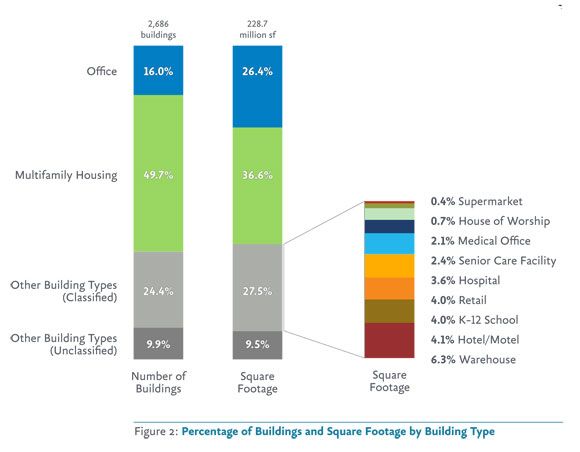Seattle already knows that its libraries perform far better than its police and fire stations when it comes to energy efficiency. But the city just got a far more complete picture of how its private building stock uses energy across the metropolis.
The Seattle Office of Sustainability and Environment released a new report that details energy use for all large commercial and multifamily buildings. The findings, which are based on EPA Energy Star scores and Energy Use Intensities (EUI), are the result of the mandatory benchmarking measure that Seattle passed in 2010.

Overall, the news out of Seattle is fairly positive. Nearly three-quarters of the approximately 900 buildings in the city that received Energy Star scores performed better than the national median average, and 41 percent of those buildings had a score higher than 75 (out of 100). Multifamily is not eligible for Energy Star scores.

Seattle is a leader, but energy benchmarking is also gaining ground in other cities and some states, including Washington, D.C., New York, Boston, Minneapolis, Chicago and California. That could give it some competition.
And there's plenty more work to be done in the city. Multifamily housing, which accounts for nearly half of Seattle's buildings, used about 31 kBTU per square feet. That is far less energy per square foo than offices, which use nearly double that amount, but the number of buildings means that multifamily could be ripe for increasing efficiency for the low performers. Low-income and affordable housing properties also had higher EUIs than other multifamily buildings.
One issue is the lack of occupancy reporting in this sector, which could skew the data. Mixed-use multifamily buildings that may have restaurants or retail could also skew the data. But the overall lower scores show that the city needs to target this sector for efficiency.

Other buildings, such as warehouses, senior care facilities and medical offices, make up only a small part of the buildings in Seattle, but have some of the lowest scores in the city overall. More than 90 percent of medical offices and 70 percent of warehouses had scores that were poor or fair.
Medical facilities may be more energy-intensive than schools or offices, but energy upgrades and equipment monitoring can cut costs without sacrificing quality. In warehouses, LEDs are an increasingly price-competitive option to decrease costs. If all of the buildings with EUIs worse than Seattle’s median brought their score up to the median, annual energy use in the city would drop by 25 percent, saving $56.1 million.
Seattle has also found that its private buildings are exhibiting the same trend as its municipal buildings. It's not the oldest buildings that perform worst, but rather the mid-century buildings that tend to have the lowest scores.
So far, the city has not seen much improvement in scores, but it can take multiple years for building owners to act on low scores and for retrofits to be completed. The city recognizes, however, that the findings should be used to reform utility energy-efficiency programs and pick sectors that could benefit from a more in-depth analysis.



